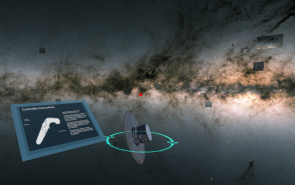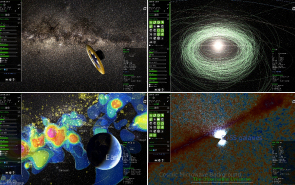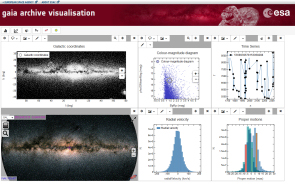Gaia Data Release 2 Virtual Reality resources
The second data release of ESA's Gaia mission contains the positions and brightness of 1.7 billion stars in our Milky Way galaxy and nearby galaxies. It also includes distance indicators, motions and colour information of 1.3 billion stars, as well as additional information about other celestial objects, based on 22 months of observations between July 2014 and May 2016.
With these data, astronomers can create the most detailed map of our Galaxy ever made. Several resources have been developed to visualise this extraordinary data set, both for public outreach and scientific exploitation purposes.
360-degree interactive visualisations
| 360° view of Gaia's sky. Click here for details and large versions of the video. Credit: ESA/Gaia/DPAC; ATG medialab; CC BY-SA 3.0 IGO |
| Parallax and proper motion on the sky. Click here for details and large versions of the video. Credit: ESA/Gaia/DPAC, CC BY-SA 3.0 IGO |
You can explore these 360-degree interactive visualisations above using a mobile device, such as a smart phone or tablet, and moving it around to view different regions of the sky. On a computer, click and drag your mouse to explore the sky in the video player.
These immersive visualisations are best experienced with a Virtual Reality Cardboard kit, using the YouTube app on a smart phone and selecting the cardboard icon on the video player.
GaiaVR: a Virtual Reality showcase of Gaia's sky
 |
GaiaVR is a Virtual Reality application developed for Windows [zipped folder, 115MB] and
for Mac OS [zipped folder, 110 MB] that provides an immersive experience of the full sky based on data from Gaia's second release.
This application can be viewed with an HTC Vive virtual reality headset and a motion-tracked handheld controller. If you don't have access to an HTC Vive set, you can still add the software on your computer and explore the 2D visualisation tool on your screen.
The software does not need to be installed. Simply download the appropriate application folder from either link above (depending on whether you have Windows or Mac OS) and place it anywhere on your computer.
Credit: ESA/Gaia/DPAC; ATG medialab
Gaia Sky: Explore the Universe as observed by Gaia
 |
Gaia Sky is a real-time, 3D, astronomy visualisation software that runs on Windows, Linux and Mac OS. It is developed in the framework of ESA's Gaia mission by the Gaia group at the Astronomisches Rechen-Institut (Zentrum für Astronomie Heidelberg, University of Heidelberg, Germany).
It contains a simulation of our Solar System, a view of the second Gaia data release (with different selections based on parallax relative errors, ranging from a few million to hundreds of millions of stars), and additional astronomical and cosmological data to visualise star clusters, nearby galaxies, distant galaxies and quasars, and the Cosmic Microwave Background.
Gaia Sky VR, the Virtual Reality version of Gaia Sky, is a real-time, 3D, astronomy Virtual Reality software that runs on multiple headsets and operating systems thanks to Valve's OpenVR.
Credit: ESA/Gaia/DPAC; Gaia Sky: Toni Sagristà, Stefan Jordan (2018)
Gaia visualisation interface for scientists
 |
The ESA Gaia archive also provides the Gaia Archive Visualisation Service (GAVS), an interactive tool to visually explore the huge potentialities of this extraordinary data set. The visualisation interface can be accessed here and relevant documentation is available here.



